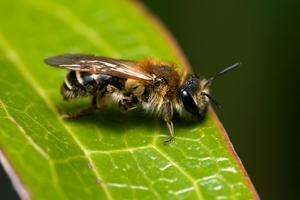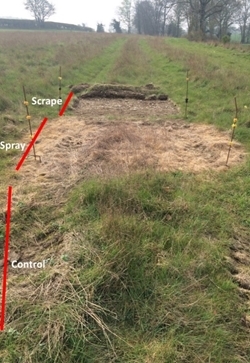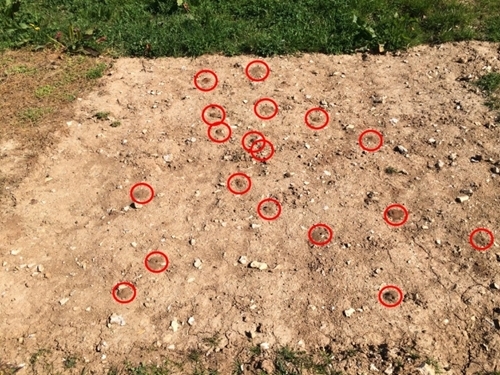Key points
- Numbers of solitary bees in the UK have declined over the past ten years.
- Some solitary bees nest in the ground and are important pollinators for crops like apples and pears.
- In 2019, this study tested whether plots of bare ground on farmland would be used by ground-nesting solitary bees.
- The scientists made and compared small plots scraped bare using machinery, sprayed with herbicide, or left undisturbed.
- The greatest number of bee nests were found on ground scraped bare.
- The scientists concluded that scraped plots created better nesting habitat for ground-nesting bees.
- With simple guidelines, scraped plots could be easily included into any country’s current agri-environment scheme.
Background
 In Britain, there are almost 250 species of solitary bee. Solitary bees do not live in colonies like bumblebees and honey bees, hence the name. The foraging behaviour and preferences of solitary bees have been well studied, but little is known about their nesting requirements. Some species nest in the ground, and this subset are known as ground-nesting solitary bees. Many of these bees are important pollinators for crops like apples, pears and strawberries.
In Britain, there are almost 250 species of solitary bee. Solitary bees do not live in colonies like bumblebees and honey bees, hence the name. The foraging behaviour and preferences of solitary bees have been well studied, but little is known about their nesting requirements. Some species nest in the ground, and this subset are known as ground-nesting solitary bees. Many of these bees are important pollinators for crops like apples, pears and strawberries.
Previous research has shown that ground-nesting solitary bees (e.g. the furrow bee and mining bee) prefer to nest in ground that is bare, firm, sloped, has certain plant cover and even soil of a specific acidity. By removing vegetation or creating areas of bare ground on farmland, ‘scrapes’ can provide good nesting habitat for solitary bees.
Across Europe, agri-environment schemes (AES) have been developed to encourage wildlife-friendly farming by providing landowners with financial support for conservation. Creating bare ground on farmland has not yet been included in any AES but could be introduced to help support ground-nesting solitary bees. The abundance and diversity of solitary bees has declined in the UK over the past ten years, so conservation on farmland would be beneficial.
This study aimed to determine whether nesting habitats for ground-nesting solitary bees could be created as small plots on farmland, and whether they would be used by the bees. If it is successful, the plots could be introduced as an AES.
What they did
 This study took place in 2019 on four farms in Hampshire. A total of 19 locations were identified for potential ground-nesting bee sites. The locations were chosen by finding compacted ground (e.g. vehicle routes at the edges of fields), with a slight slope and on the south side of hedgerows or trees.
This study took place in 2019 on four farms in Hampshire. A total of 19 locations were identified for potential ground-nesting bee sites. The locations were chosen by finding compacted ground (e.g. vehicle routes at the edges of fields), with a slight slope and on the south side of hedgerows or trees.
At each location, three plots around 6m2 were marked out. One plot was scraped bare using machinery, a second plot was sprayed with herbicide, and a third plot was left undisturbed as a control plot. All the plots were made during March 2019 at a time that was convenient for the farmer and during weather suitable for the use of herbicide (i.e. not raining).
The plots were surveyed once a month from April to July 2019. During these surveys, the scientists recorded the percentage cover of plants in each plot and counted the number of new nests in the ground. The scientists also watched each plot for five minutes and recorded the activity of any nesting bees. Where possible, they caught the bees and identified the species.
What they found
Four species of solitary bee were identified and one species of solitary wasp.
Throughout the study, the scientists counted 274 nests: 235 in scraped plots, 35 in sprayed plots, and 4 in control plots. The greatest number of nests were found in the scraped plots, with most of the nests being found during the April survey. After April, the number of new nests found in scraped plots decreased and was similar to the number of new nests found in sprayed and control plots.
 Fresh nests found in a single scrape in April 2019.
Fresh nests found in a single scrape in April 2019.
There was a significant difference in plant cover between the types of plot and the month. Scraped plots had lower plant coverage overall. By July, scraped plots still had 50% bare ground. The sprayed plots had an average of 31% of bare ground showing throughout the study and mainly contained dead plants that had been killed by the herbicide. The control plot only had an average of 3% bare ground showing throughout the study.
Throughout the study there was a difference in plant height between the plots. Plant height in the scraped plots and sprayed plots stayed at a similar level. The plant height increased in these plots over the summer but still stayed lower than the control plots.
Lastly, the scientists found that there were more nests on south-facing slopes, which is what previous research on ground-nesting bees has shown.
What does this mean
Scraped plots created better nesting habitat for ground-nesting bees than the sprayed or control plots. The scientists recommend that scrapes are created using a digger or similar farmyard machinery in the compacted ground around the edges of fields (field margins). South-facing slopes would be ideal if available.
The scrapes created in this study were not difficult or time-consuming to create, did not take up a lot of space, and were located in uncropped areas of farmland. These characteristics of scrapes make them a cost- and time-effective AES option to increase potential ground-nesting sites for solitary bees and wasps.
With simple guidelines, scraped plots could be easily included into any country’s current agri-environment scheme.
Read the original abstract
Nichols R. N., Holland J. & Goulson D. (2020) Methods for creating bare ground on farmland in Hampshire, UK, and their effectiveness at recruiting ground-nesting solitary bees. Conservation Evidence, 17, 15-18.